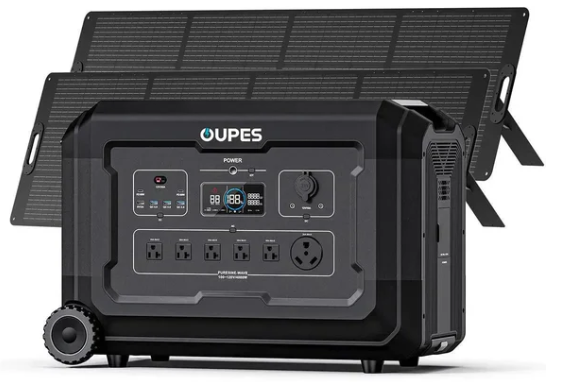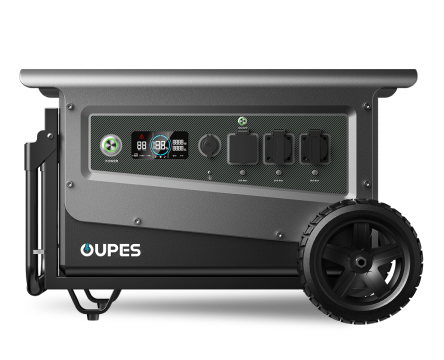
Table of Contents
- Introduction: Why Home Backup Power Matters
- How Backup Power Systems Work
- Main Types of Home Backup Power Supplies
- Comparison Table: Backup Power Options
- How to Choose the Right Backup System
- Why Solar Generators and Portable Power Stations Are Rising in Popularity
- Installation and Maintenance Considerations
- Future Trends in Backup Power Technology
- FAQ
Introduction: Why Home Backup Power Matters
From extreme weather to grid instability, power outages are increasingly common. According to the U.S. Department of Energy, the average American household experiences at least one power interruption per year, with some lasting hours or even days. Having a reliable home backup power supply ensures critical systems — such as refrigerators, medical equipment, and communication devices — remain operational during emergencies.
In this article, we’ll explore the various types of backup power systems available for homes, their advantages, drawbacks, and which might suit your energy needs best. We’ll also discuss how portable power stations and solar generators — like those from OUPES — are reshaping how families stay powered during outages.
How Backup Power Systems Work
A backup power system provides electricity when the main grid supply fails. These systems either generate power on-site (like generators) or store energy for later use (like batteries). Once the grid goes down, the system automatically or manually transfers to backup mode, supplying electricity to essential circuits or the entire home.
Key Components of a Backup Power System
- Power Source: Could be gasoline, natural gas, propane, solar, or stored battery energy.
- Inverter: Converts direct current (DC) to alternating current (AC) for household use.
- Transfer Switch: Automatically shifts power supply from the grid to the backup system.
- Battery Storage (optional): Stores power generated from renewable sources for later use.
Main Types of Home Backup Power Supplies
1. Gasoline Generators
Gas-powered generators are among the most common emergency power solutions. They are typically affordable and can power high-wattage devices, such as HVAC systems or water pumps. However, they are noisy, produce emissions, and require fuel storage and regular maintenance.
2. Propane Generators
Propane generators burn cleaner than gasoline and have a longer shelf life for stored fuel. They’re suitable for homes that already use propane for heating or cooking. Still, propane tanks require space, and refueling during emergencies can be challenging.
3. Natural Gas Generators
These units are connected directly to the home’s natural gas line, providing continuous fuel supply during grid failures. They’re reliable and automatic but come with high upfront installation costs and rely on an uninterrupted gas network.
4. Diesel Generators
Diesel models offer durability and energy efficiency, making them a common choice for commercial or rural use. They can run for long periods but are louder, emit more pollutants, and require periodic engine maintenance.
5. Battery Backup Systems
Battery backup systems store energy from the grid or renewable sources. They’re silent, emission-free, and activate instantly during outages. Modern lithium iron phosphate (LiFePO₄) batteries, used in many residential systems, last over 10 years with thousands of charge cycles.
6. Solar Generators
A solar generator combines solar panels, a battery, and an inverter to create a self-sustaining energy system. During sunlight hours, panels charge the battery, which powers appliances at night or during outages. Solar generators are sustainable, low-maintenance, and suitable for off-grid living.
7. Portable Power Stations
Compact and versatile, portable power stations are rechargeable battery systems that provide AC and DC output. They’re ideal for powering essential electronics during blackouts, outdoor events, or RV trips. When paired with solar panels, they become renewable, emission-free backup power sources. Brands like OUPES have advanced models with multiple output ports, LiFePO₄ batteries, and smart monitoring systems for home and outdoor use.
Comparison Table: Backup Power Options
| Type | Power Output | Fuel Source | Maintenance | Noise Level | Environmental Impact | Cost Range (USD) |
|---|---|---|---|---|---|---|
| Gasoline Generator | 2–10 kW | Gasoline | High | 60–80 dB | High emissions | $500–$2,000 |
| Propane Generator | 3–15 kW | Propane | Moderate | 60–75 dB | Moderate emissions | $1,000–$4,000 |
| Natural Gas Generator | 7–20 kW | Natural Gas | Low | 60–70 dB | Lower emissions | $2,000–$10,000 |
| Diesel Generator | 5–30 kW | Diesel | High | 70–85 dB | High emissions | $1,500–$6,000 |
| Battery Backup System | 3–10 kW | Stored electricity | Low | Silent | Zero emissions | $5,000–$12,000 |
| Solar Generator | 1–7 kW | Solar energy | Low | Silent | Zero emissions | $800–$5,000 |
| Portable Power Station | 300–4000 W | Rechargeable battery | Low | Silent | Zero emissions | $300–$3,000 |
How to Choose the Right Backup System
1. Assess Your Power Needs
Identify which devices you need to run during an outage — refrigerator, lights, medical devices, or Wi-Fi router — and total their wattage. Your total determines whether you need a whole-house generator or a portable system.
2. Consider Outage Frequency
If outages are rare, a small portable power station or solar generator might suffice. For areas prone to storms or grid instability, a more permanent system such as a natural gas or hybrid battery backup is better.
3. Evaluate Noise and Emissions
Gas and diesel generators are powerful but noisy and polluting. Battery and solar solutions offer silent, clean power ideal for indoor or suburban use.
4. Budget and Long-Term Value
While traditional generators have lower upfront costs, solar and battery systems offer long-term savings by eliminating fuel expenses and reducing maintenance.
Why Solar Generators and Portable Power Stations Are Rising in Popularity
The shift toward sustainability has made solar-based systems increasingly attractive. Unlike fuel-powered generators, solar generators and portable power stations operate silently, require no fuel, and can recharge through renewable energy. They’re ideal for homeowners seeking both emergency preparedness and energy independence.
Advantages
- Completely renewable energy source.
- Low operating costs and maintenance.
- Safe for indoor and outdoor use.
- Expandable with additional solar panels or batteries.
Example Use Case
A family using an OUPES solar generator can keep essential devices like refrigerators, communication systems, and lighting running for 12–24 hours during outages — all without fuel dependency or noise pollution.
Installation and Maintenance Considerations
1. Professional Installation vs. DIY
Permanent systems like natural gas or whole-home batteries require certified electricians. Portable power stations and solar generators, however, are designed for easy DIY setup — simply plug in and power up.
2. Regular Maintenance
Fuel-based generators need oil changes, fuel checks, and routine testing. Battery and solar systems require minimal upkeep — mostly dusting solar panels and ensuring good ventilation.
Future Trends in Backup Power Technology
By 2030, the global home backup power market is expected to exceed $30 billion (Source: BloombergNEF). Key innovations shaping the future include:
- Integration of AI for smart energy management.
- Faster solar charging and high-efficiency inverters.
- Widespread adoption of LiFePO₄ and solid-state batteries.
- Hybrid systems that combine solar, grid, and generator inputs.
As renewable technology matures, the boundary between home and off-grid power will continue to blur — offering consumers reliable, sustainable, and independent energy solutions.
FAQ
1. What is the best home backup power supply?
It depends on your needs. For eco-friendly, quiet operation, solar generators or battery systems are ideal. For heavy-duty power, natural gas or diesel generators perform best.
2. How long can a portable power station run a refrigerator?
A 2000Wh portable power station can run a standard refrigerator for 10–12 hours continuously, longer with energy-saving practices.
3. Are solar generators powerful enough for entire homes?
While smaller systems can power essential appliances, larger setups — or hybrid configurations — can sustain entire households.
4. What’s the lifespan of a home backup battery?
Modern LiFePO₄ batteries last over 10 years and support 3000–5000 charge cycles, depending on use and maintenance.
5. Why should I consider a portable solar generator?
Portable solar generators combine mobility, quiet operation, and renewable energy — making them perfect for both daily use and emergency backup.




























